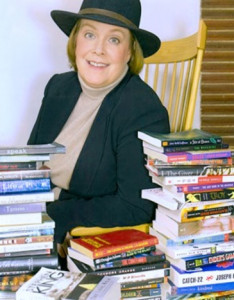The Two Golden Ages of Children’s Publishing
The last fifty years have seen huge advances in virtually every industry. The changes in the children’s book industry are no exception as we have gone from one golden age of publishing to the next. Anita Silvey and John Briggs are both contributors to and witnesses of those tumultuous decades. Both kindly took time out of their busy schedules to share memories and perspectives.
 The mid 1960s were indeed a golden time in publishing. “The passage of the Elementary and Secondary Education Act of 1965 provided an immense amount of money for school libraries,” explains John Briggs, President of the venerable publisher Holiday House. “Our response was the same as everyone else’s—we reprinted like mad!” Funds had to be spent by specific deadlines or they would disappear—a dynamic which created a new sense of urgency. Children’s departments within the larger houses were given more support and autonomy and more independent publishers joined Holiday House as houses dedicated specifically to books for children.
The mid 1960s were indeed a golden time in publishing. “The passage of the Elementary and Secondary Education Act of 1965 provided an immense amount of money for school libraries,” explains John Briggs, President of the venerable publisher Holiday House. “Our response was the same as everyone else’s—we reprinted like mad!” Funds had to be spent by specific deadlines or they would disappear—a dynamic which created a new sense of urgency. Children’s departments within the larger houses were given more support and autonomy and more independent publishers joined Holiday House as houses dedicated specifically to books for children.
By the end of the 1960s, another shift was taking place. Paperbacks were becoming a growth market for children’s books who had previously not considered the format. “The rise of paperbacks has been a big impact,” notes John. “Our response was to develop a list to the point where we now sell more paperbacks than hardcovers.”
 Anita Silvey sees some similarities between today’s publishing climate and that of the late 60s. She notes that “Anytime there is a sales carrot, it gives an incentive,” and today’s carrot is the Common Core State Standards. Back in the 60s, “Everyone was creating quality nonfiction because they could sell them, but what makes it work—both then and now–is the creativity of writers and houses.” For example, John Briggs’ Holiday House began a long relationship with picture book nonfiction queen Gail Gibbons. It is fruitful as well since they now have nearly 100 editions in print including the recent The Fruits We Eat.
Anita Silvey sees some similarities between today’s publishing climate and that of the late 60s. She notes that “Anytime there is a sales carrot, it gives an incentive,” and today’s carrot is the Common Core State Standards. Back in the 60s, “Everyone was creating quality nonfiction because they could sell them, but what makes it work—both then and now–is the creativity of writers and houses.” For example, John Briggs’ Holiday House began a long relationship with picture book nonfiction queen Gail Gibbons. It is fruitful as well since they now have nearly 100 editions in print including the recent The Fruits We Eat.
John notes that “In 1970 we were relatively passive when it came to adding to our list.” Today, “The books we publish now are much broader in both subject matter and in the way they reflect the different society we live in.”
While John Briggs’ career has been entirely at Holiday House, Anita Silvey has donned many hats during her decades in the business. Her career has been divided between publishing and evaluating children’s books and includes time as editor for The Horn Book, known as the “Bible” of children’s book review and serving as Publisher for Houghton Mifflin. She has become the go-to children’s literature expert for news sources and has also written books for children including this year’s Untamed: The Wild Life of Jane Goodall.
“The industry was smaller when I came into it in 1970,” reflects Anita. “It was more personal and we all knew each other. It was a wonderful time to be apprenticed in publishing.” She finds the “conglomeratization worrisome” in recent years yet finds much to celebrate. The reliance on color separation fell away in the late 70s which empowered artists to create in any medium. With the advent of ebooks, publishers have had to find new ways to distinguish their printed product. “They invest in the design and even the paper” to create a distinctive book-feel.
Silvey also notes that mainstream culture began to take note of what was happening in the children’s book world. “Picture books were no longer ‘ghettoized’’ and Harry Potter became a world-wide phenomenon. “The boundaries opened up” and were pushed by creators including Brian Selznick, whose The Invention of Hugo Cabret” was such a “brave idea.” The assumption that older kids didn’t need picture books went by the wayside as photobiographies, graphic novels, and more became mainstream.
The graphic novel is particularly intriguing as it presents the opportunity for a “flexibility of order,” notes Silvey with even picture book masters like David Wiesner trying their hand. She adds that books like Brian Floca’s Caldecott-winning Locomotive would not have been published even ten years ago. And a John Green book is still a John Green book and will find its ever-growing audience, whatever the format.
The teen fiction explosion has created myriad opportunities for both publishers and readers and one of the results is an entirely new category–New Adult.
“The talent I see going into publishing give me hope for the future,” confides Anita. “People are coming into the industry for every right reason.” Yet, she reminds us that in children’s books, “Never being cynical is so important.” John Briggs has this advice to those interested in a career in children’s publishing: “Go for it—having passion helps.”
Anita points out that “People remember the person who gave them the children’s book that changed their lives.” She knows this because a life-changing book is part of her own most recent authorial effort. It was a copy of Tarzan that sparked the young Jane Goodall into her life’s work.
Are we in a new golden age of children’s book publishing? The answer, as revealed by the critics, the creators, and the award juries points to a resounding “Yes!” Even though the publishing process has evolved and formats have multiplied, children’s books have shown what Anita calls a “tenacity” that ensure their future.
Interested in learning more?
Read these books to learn more about the history of children’s book publishing
“The Essential Guide to Children’s Books and Their Creators by Anita Silvey” (Mariner Books, 2002)
“Minders of Make Believe by Leonard Marcus” (Houghton Mifflin, 2008)
